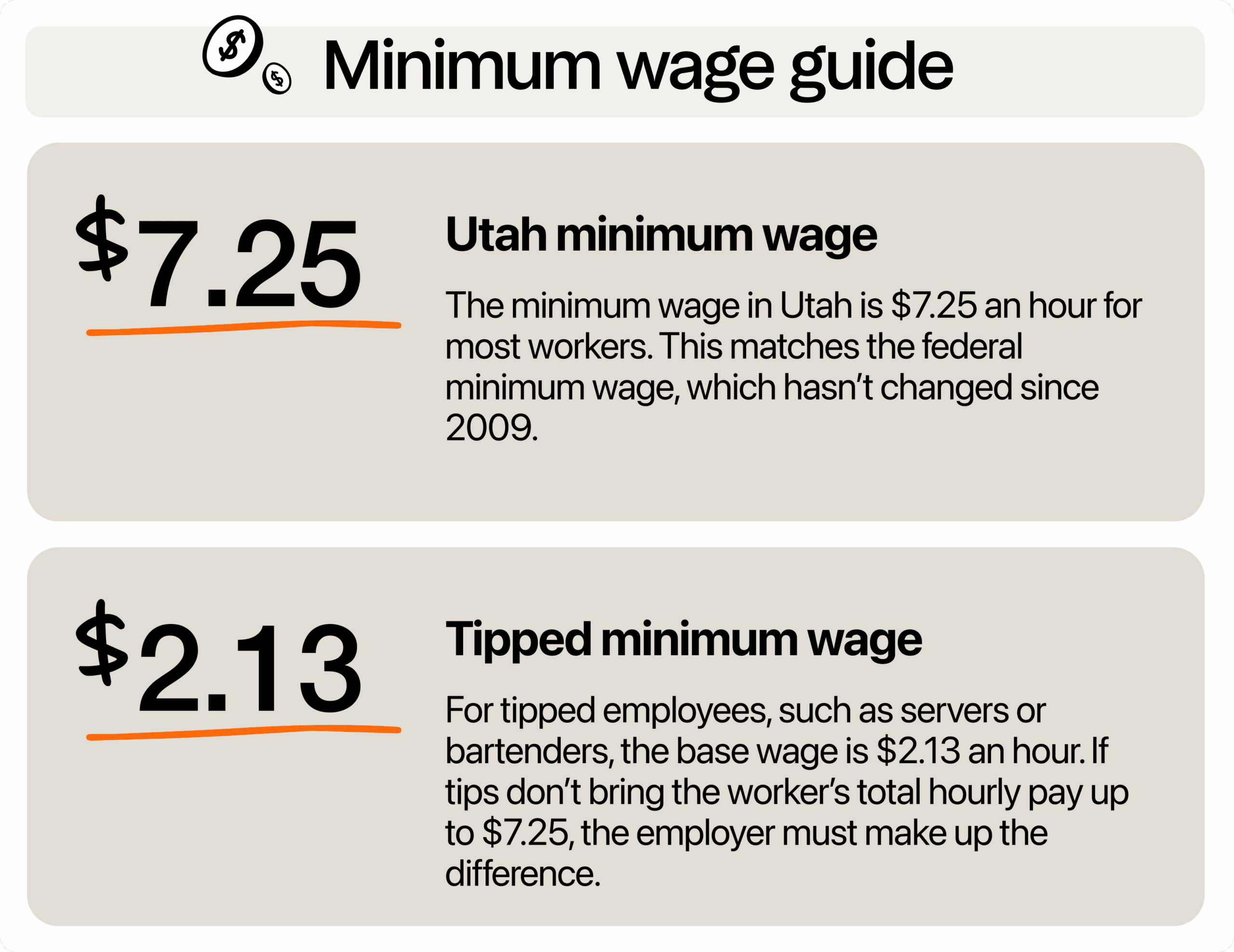Utah’s minimum wage is one of the lowest in the country, as it still follows the federal rate. That means workers may be earning less than half of what’s needed to cover basic needs, and you’re stuck trying to compete with nearby states offering more.
It’s become all the more important to understand wage laws and figure out strategies that can help you attract and retain top employees. You should also stay updated with legislative changes, which can affect your restaurant budget and margins. With the right tools and strategy, you can build a stronger, happier crew, and still protect your bottom line.

What is the minimum wage in Utah in 2025?
As of 2025, the minimum wage in Utah is $7.25 an hour for most workers. This matches the federal minimum wage, which hasn’t changed since 2009. Utah is one of the few states that still follows the federal minimum without a separate state minimum wage.
For tipped employees, such as servers or bartenders, the base wage is $2.13 an hour. If tips don’t bring the worker’s total hourly pay up to $7.25, the employer must make up the difference. For example, if a server only makes $3 in tips during an hour, their company must pay an extra $2.12 to reach the minimum wage.
The Utah labor department also follows federal rules for training wages. New hires under the age of 20 can legally be paid $4.25 per hour, but only for their first 90 days of work. After that, they must be paid the full $7.25. In some cases, high school or college students working part-time (like in a school work-study program) can be paid 85% of the minimum wage (or $6.16), as long as it’s under 20 hours per week.
For hourly workers who work more than 40 hours in a week, the Fair Labor Standards Act (FLSA) requires overtime pay, which is 1.5 times their regular wage. That means if someone earns $7.25, their overtime rate would be $10.88 an hour.
How does Utah’s minimum wage compare to neighboring states?
The difference is hard to miss when you compare Utah’s rate to nearby states. The minimum wage in Arizona is $14.70 per hour, while Colorado’s is slightly higher at $14.81. New Mexico and Nevada both have a minimum wage of $12 per hour.
These higher rates across state lines make it tough for Utah businesses to compete for talent, especially when workers can earn almost twice as much by driving just a few miles.
If you own a restaurant near St. George, for example, you might be competing with Nevada businesses paying $4.75 more per hour. In Westwater, you’re just a quick drive from Fruita, where the minimum wage is nearly double.
This pay gap makes it harder for employers in Utah to find and keep good workers. When cooks, servers, and dishwashers can earn several dollars more per hour just by working one town over, it’s no surprise they move.
The problem is that the cost of living is three times the minimum wage in Utah. A single adult needs to earn at least $23.91 per hour to cover basic expenses like food, rent, and transportation. Even someone working 40 hours a week would fall short of meeting their basic needs, let alone support a family.
Many full-time workers on $7.25 must work multiple jobs or depend on public support just to get by. Meanwhile, Arizona and Colorado adjust their minimums each year to reflect inflation and cost-of-living increases.
If the goal is to stay competitive, Utah restaurants may need to look beyond what’s legally required and think about what’s realistically needed to retain staff.
Is there a law to increase the state minimum wage?
There’s no law in Utah to raise the state wage above the federal minimum of $7.25 an hour. Several bills have been introduced in recent years aiming to raise the minimum wage, but none have passed.
For example, House Bill 205 was introduced in 2024 to raise wages but was rejected in committee. Another more ambitious bill, House Bill 549, first proposed in 2023 and revisited for the 2025 session, aimed to set up an age-based wage system, but that too failed to pass.
Here’s what HB549 had proposed:
- Under 18: $10/hour
- Ages 18–20: $13/hour
- Ages 21–22: $15/hour
- Ages 23+: $19/hour
The bill even included a plan to adjust wages annually for inflation starting in 2027. But again, it didn’t make it through the legislature.
How does one attract and keep employees with minimum pay?
Utah’s minimum wage just serves as a guideline for businesses. You can choose to pay more to show that you care for your employees’ well-being. Paying a little bit higher than the federal rate, like at $8 or $8.50 per hour, can make a huge difference to your team without sacrificing your bottom line. Nonetheless, if you can’t pay more than minimum yet, you can still find ways to show you value their part in your restaurant.
Offer more than just a paycheck
The small things you do as an employer can make a big difference in keeping your staff motivated and loyal. Start with employee appreciation and recognition. A thank-you at the end of a shift, celebrating someone’s birthday, or giving shout-outs for jobs well done can boost morale.
Team culture also plays a huge role. Employees want to work where they feel safe, respected, and part of something. This can be as simple as starting each shift with a quick check-in or organizing a staff potluck once a month. You don’t have to spend big. You just need to create a space where people actually want to show up.
Perks help, too. Can you offer free or discounted meals during shifts? Can you build schedules around staff availability to help them balance life and work? Even if you can’t raise pay beyond the minimum, being flexible with scheduling shows you care.
Restaurant scheduling software makes it easier to stay on top of your team’s available hours. 7shifts lets you build schedules easily based on staff preferences, reducing conflicts and improving attendance.
Invest in onboarding and training
No matter how experienced or seasoned a new hire is, they still need to be acclimated to your culture and workflows. A strong onboarding process can be the reason someone stays or leaves.
Set expectations early. A clear, structured first week helps workers feel confident. Explain how shifts work, who they report to, what success looks like, and how their role fits into the bigger picture. A printed guide or a quick daily checklist makes expectations easy to follow, even for new hires juggling multiple jobs.
Cross-training is another strategy that can set you apart from other employers. Teach your host to run food, or your dishwasher to prep veggies. It’s a win-win situation, really. You get to fill gaps when someone calls out and boost your team’s skills at the same time.
Don’t stop there. Even if you’re paying the federal minimum, you can offer a path forward. Whether it’s a shift lead role, a move from FOH to BOH, or learning to use the POS system, growth matters. Highlight people on your team who’ve worked their way up. That sends a clear message: “You can grow here.”
Create an environment people want to work in
When you’re paying minimum wage, the workplace experience matters just as much as the paycheck. Foster respect and trust. Every employee, from your dishwasher to your lead server, wants to feel valued. This means listening when they speak, addressing concerns quickly, and treating everyone fairly.
Open communication is key. That doesn’t mean holding formal meetings every day, but it does mean making time for feedback and letting your team know what’s happening behind the scenes. Even a weekly check-in or shared update board can go a long way. When people know what to expect, they feel more secure.
Also, don’t ignore the dynamics between FOH and BOH. Tension between servers and kitchen staff can ruin a shift. Make it a priority to build healthy team relationships. Things like shared staff meetings, team-building days, or even just cross-training can help bridge gaps.
And watch your managers closely. A great manager builds teams up. A toxic one tears them down fast. The bottom line: people don’t quit jobs; they quit managers. In our 2024 restaurant employee engagement report, we found that 45% left a job because of negative experiences with their managers or supervisors.
The team leaders you place can make or break your restaurant’s success. Invest time in training and supporting your managers to create a positive, inclusive environment.
Track team sentiment
It’s important for employers to keep a pulse on how their team is really feeling. You don’t need fancy tools to do it. Even simple check-ins and short surveys can help you spot problems before they turn into bigger issues.
Ask how your team is doing at the start or end of a shift. Keep it casual but consistent. These chats show your staff that their experience matters. If someone’s tired, overwhelmed, or just needs a change, it’s better to hear it directly than find out when they stop showing up.
You can also use anonymous surveys. These are especially helpful for shy or newer workers who might not speak up. Keep the questions short. Things like “Do you feel heard at work?” or “Is your workload manageable?” This helps uncover how your team really feels, even if they’re not saying it out loud.
Watch for signs of burnout or disengagement, too. If someone who’s usually upbeat starts missing shifts or zoning out during service, that’s a red flag. At $7.25 per hour, employees can easily walk away if they feel unseen or unsupported.
And when there’s conflict? Don’t wait. Whether it’s tension between FOH and BOH or a clash between two servers, small problems can grow quickly in tight spaces. Pull staff aside, hear all sides, and resolve things before they spread to the rest of your team.
How can small business owners prepare for wage changes in UT?
Keeping up with wage laws is one of the important legal tasks that restaurant owners should be doing. Aside from staying compliant, you also need to monitor changes so you can plan your budget and staffing strategies effectively.
Make sure to follow or subscribe to local government resources and local restaurant associations. They often provide timely updates about minimum wage regulations and potential legislative changes.
Even though proposals for wage increases haven’t passed yet, you need to stay on your toes and be prepared in case they do push through. Knowing where your money goes is important.
Check how labor fits into your total overhead. Take note that this doesn’t just include hourly wages, but also payroll taxes, overtime, and benefits.
For many restaurants, labor accounts for 29% to 33% of total operating costs. If that number creeps too high, profits can disappear quickly. Use simple reports or spreadsheets to track your weekly payroll and compare it to your sales. This helps you see trends and spot any red flags.
Next, plan ahead. One of the smartest moves employers can make now is to run “what-if” scenarios for wage increases.
Start by modeling what would happen if wages increased to $10, $15, or even $19 per hour. These reflect past legislative proposals like HB549, which aimed to raise employee wages in steps based on age.
Use your current payroll numbers and plug in the new rates to see how much your labor costs would grow. Then compare that to your average weekly or monthly revenue. This gives you a clear idea of how a future minimum wage hike could affect your bottom line.
Afterward, think through how these wage changes would affect pricing, margins, and staff levels. Would you need to raise menu prices? Could you trim hours during slow periods without hurting service? Could one person cover multiple roles if needed?
If it’s possible, start small now. Offering even a voluntary raise, like boosting your lowest-paid staff from $7.25 to $8 per hour, can help you ease into the cost. It also shows your team that you’re preparing and that you value their work, even before the state minimum wage goes up.
Scenario planning may sound complicated, but it’s really about knowing your numbers and having a plan. Whether you’re running a taco truck or a family diner, you’ll be in a stronger position if the wage floor changes, because you’ll already know what comes next.
Deploying smarter strategies for a stronger team
Utah’s $7.25 minimum wage doesn’t go very far in today’s economy, but that doesn’t mean your hands are tied. As a business owner, you have the power to create a place where people want to work, even if you can’t offer top-dollar pay. Small changes like better scheduling, cross-training, and open communication can help you build a stronger, more loyal team.
At the same time, it’s smart to prepare for the future. Laws may shift, and higher wages may be on the table again soon. If you’re already thinking about how to handle those changes, you’ll be in a better spot than most.
Optimize your schedules and foster open communication with restaurant management software. 7shifts allows you to create schedules easily based on your team’s availability and lets them swap shifts through the app. This way, you empower your employees and create a more collaborative workplace environment.

Rebecca Hebert, Sales Development Representative
Rebecca Hebert
Sales Development Representative
Rebecca Hebert is a former restaurant industry professional with nearly 20 years of hands-on experience leading teams in fast-paced hospitality environments. Rebecca brings that firsthand knowledge to the tech side of the industry, helping restaurants streamline their operations with purpose-built workforce management solutions. As an active contributor to expansion efforts, she’s passionate about empowering restaurateurs with tools that genuinely support their day-to-day operations.
